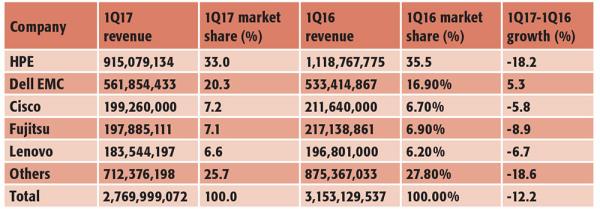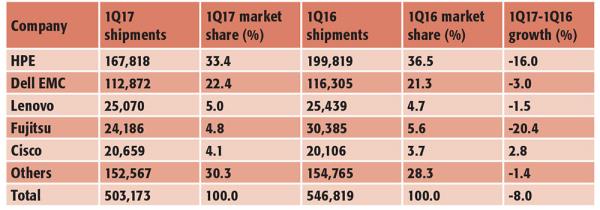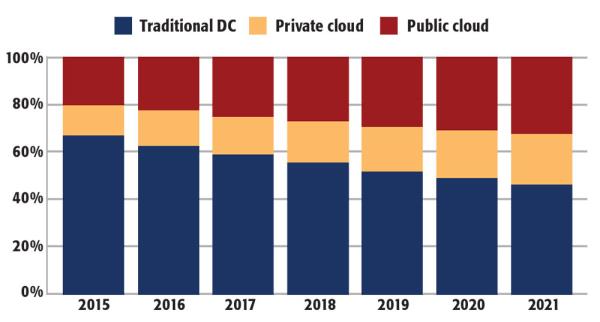01 November 2017

With nothing but praise heaped upon cloud and all that it offers, you’d be forgiven for thinking that this now represents the only way forward for enterprise IT, and that the death knell for on-premise hardware has well and truly rung.
Indeed, if the humble server epitomises the type of on-premise infrastructure that is most at risk from a cloud migration, the forecasts are not looking good.
For instance in June, International Data Corporation’s (IDC) server tracker showed that in the first quarter of this year, the EMEA server market saw a year-on-year decrease of 1.4 per cent in units shipped to just over 530,000, and a decline in vendor revenues of 12.7 per cent to $2.7bn. HPE remained at the top of the Western European server market, though earnings for the firm in this sector fell 21.4 per cent year-on-year. According to IDC, Dell was the only major manufacturer to see growth in Western Europe during the quarter.
Michael Ceroici, the company’s research analyst for European Infrastructure, says: “Server revenues in Western Europe continued to decline in 1Q17. In particular, IBM server revenues decreased 50.3 per cent due to declining non-x86 shipments and a continuing trend for extended refresh cycles.”
IDC adds that while sales of non-86 servers fell 30 per cent year-over-year, x86 server sales saw only a moderate decline of 3.2 per cent during the same period, benefiting from hardware demand by cloud service providers.
Gartner’s research is in line with IDC’s findings, although it also includes Fujitsu in its list of top five server vendors in EMEA, estimating that the company’s 1Q17 market share was 7.1 per cent and ahead of Lenovo at 6.6 per cent (see table 1).

Table 1: Top five server vendors in EMEA and their revenues for the first quarter of this year. SOURCE: GARTNER (JUNE 2017)

Table 2: EMEA server shipment estimates per unit for the first quarter of this year. SOURCE: GARTNER (JUNE 2017)

IDC predicts that total global spending on IT infrastructure products for cloud environments will reach $40.1bn in 2017, with public cloud exhibiting growth over the next few years. SOURCE: IDC WORLDWIDE QUARTERLY CLOUD IT INFRASTRUCTURE TRACKER, 1Q17
In September, Gartner issue data for 2Q17 and said global shipments of RISC/Itanium Unix servers fell globally, down 21.4 per cent compared to 2Q16. It also said shipments for x86 servers grew 2.5 per cent during the period. The researcher attributes the increase to strong performance in Asia/Pacific because of data centre infrastructure build-outs (mostly in China), and the ongoing hyperscale data centre growth that is represented by the self-build/original design manufacturer segment.
So what do the analysts say about cloud?
Spend, spend, spend
IDC reckons total global spending on IT infrastructure products (server, enterprise storage and Ethernet switches) for deployment in cloud environments will increase 12.4 per cent year-over-year in 2017 to reach $40.1bn.
The firm states that increased spending on cloud IT infrastructure and decreasing investments in non-cloud IT infrastructure will be a common theme for all regions. It says global spending on traditional, non-cloud, IT infrastructure will fall 4.6 per cent in 2017, accounting for 58.7 per cent of the overall end-user spending on servers, enterprise storage and Ethernet switches. That’s down from 62.6 per cent in 2016.
In all three technology segments, IDC says spending on IT infrastructure deployed off-premises will grow in 2017 while spending on on-premises environments will decline. Natalya Yezhkova, the company’s research director for enterprise storage, says: “Enterprise adoption of hybrid and multi-cloud IT strategies and the proliferation of cloud-native applications and areas such as the IoT will fuel further increases in end-user spending on services-based IT. In turn, this move will be reflected in a shift of the overall spending on IT infrastructure from on-premises to off-premises deployments and from traditional IT to cloud IT.”
According to the forecasts, Ethernet switches will be the fastest-growing technology segment in cloud IT environments, while spending on servers and enterprise storage will grow 9.1 and 12 per cent, respectively.
In some of its latest forecasts published in October, Gartner predicts that the global public cloud services market will be worth $260.2bn in 2017, up from $219.6bn last year. According to research director Sid Nag, one of the reasons for this is that the SaaS market is expanding faster in 2017 than previously expected, leading to a “significant uplift” in the entire public cloud revenue forecast. SaaS revenue is expected to reach $58.6bn in 2017, up from $48.2bn in 2016.
Gartner says the acceleration in SaaS adoption can be explained by providers delivering nearly all application functional extensions and add-ons as a service. It believes that this appeals to users because SaaS solutions are engineered to be more “purpose-built” and are delivering better “business outcomes” than traditional software.
The analyst expect the highest revenue growth to come from IaaS which is projected to reach $34.7bn in 2017. Nag adds that strategic adoption of PaaS offerings is also outperforming previous expectations. He says: “Enterprise-scale organisations are increasingly confident that PaaS will be their primary form of application development platform in the future.”
Although public cloud revenue is growing more strongly than initially forecast, the firm still expects growth even beyond 2018. It says this reflects the increasingly mainstream status and maturity that public cloud services will gain within a wider IT spending mix.
“As of 2016, approximately 17 per cent of the total market revenue for infrastructure, middleware, application and business process services had shifted to cloud,” says Nag. “Through 2021, this will increase to approximately 28 per cent.”
Every silver lining has a cloud
So it would seem that the cloud can do no wrong. Or can it?
For example, the platform is often hailed as the future of data storage but live chat specialist Parker Software warns that there are still risks involved and believes there remains a strong demand for on-premises systems instead.
“Headlines suggest that cloud storage provides the most cost-effective hosting model, but that’s not necessarily true,” says the company’s CEO Stephen Parker. “Research [from Computerworld’s Tech Forecast 2017 survey] suggests that 31 per cent of IT departments have hit roadblocks for cloud delivering business value. What’s more, six per cent reported no or very little value from a cloud-based model.”
The firm also highlights performance issues with cloud-based services. Quoting data from Dynatrace’s Global Digital Performance and Transformation Audit, it says 50 per cent of UK companies experience digital performance issues on at least a weekly basis (if not more often), and that on average, businesses experience 27 hours of downtime per month, according to IHS Markit’s Cost of Server, Application and Network Downtime Survey and Calculator – 2016.
Parker goes on to claim that the cost of such cloud problems is “sky-high”. Citing the Ponemon Institute’s Cost of Data Center Outages report published last year, the firm says data centre outages cost companies nearly $9,000 per minute, and that 57 per cent of businesses have reported that high charges and provider fees are a “major issue” with cloud providers.
“There’s no denying the innovation of the cloud and the storage model certainly does have its benefits,” says Parker. “[But] the notion that the cloud is the answer to every business hosting problem is exaggerated. Admittedly, with the right provider and under the right circumstances, cloud storage can be effective – but it is not necessarily right for everyone.”
As a result, Parker says only 10 per cent of UK businesses have moved completely to the cloud (Information Age, 19 Jul 2017), while 21 per cent of technology pros responding to the Tech Forecast 2017 survey cited above said they have no plans to switch.
And in contrast to the predictions made by IDC and Gartner above, the company says that even by 2020, more than 50 per cent of spending on IT infrastructure will remain on traditional data centres (GCN, 17 May 2017).
And then of course, there’s that old chestnut of security. Referencing a 2014 cloud security global study from BT, the company says 76 per cent of IT decision-makers say this is their main concern about using services, while 35 per cent think cloud is less secure than on-premises software (from The Cloud Balancing Act for IT: Between Promise and Peril report published in 2016 by the Cloud Security Alliance and Skyhigh Networks).
Compliance with regulatory issues is also flagged as a concern, particularly with the EU’s General Data Protection Regulation coming up (see feature “If you can’t stand the heat…”, May 2016 issue), and the UK’s latest Data Protection Bill which gives the Information Commissioner’s Office more power to issue higher fines of up to £17m or four per cent of global turnover in cases of the most serious breaches.
The security issue: red herring or beached whale?
When it comes to compliance, Alex Hilton, CEO of the Cloud Industry Forum (CIF), agrees that regulation is obviously a key consideration for the financial services industry and public sector. But he adds that frameworks are rapidly evolving and are not the absolute barrier to the adoption of cloud services they once were. “For example just last year, the Financial Conduct Authority softened its stance on public cloud in the financial services industry, which I think says a lot about how far we’ve come.
“The key here is conducting your due diligence – understanding where your data is going to be hosted, to ensure that you’re covered from a data sovereignty point of view, what safeguards there are in place to protect it, and how you can migrate your data back if or when the relationship ends.”
In terms of the General Data Protection Regulation (GDPR), Hilton reckons this will prove to be one of the main drivers towards cloud and away from legacy technology going forward.
“Some legacy technology makes it difficult to comply with the data handling obligations of the GDPR – such as the ‘right-to-be-forgotten’ – as you find that data is trapped in silos and in unreadable formats, and legacy wasn’t necessarily written with security top of mind. The new breed of cloud services are much more streamlined and have security written in to them, and so they will make GDPR compliance less of a challenge.”
And as far as security goes, Hilton says that while this comes out as the number one concern for end users in the CIF’s research, it is a “red herring” which he thinks many businesses are now starting to realise.
“You need to consider the security of every technology, whether it’s in the cloud or on-premise – it’s good business sense. In most cases, cloud is as secure as on-premise IT, if not more so. Cloud service providers invest considerable amounts of time and money in keeping their services safe, and their brand and reputation depends upon this.”
Lawrence Jones, CEO of hosting specialists UKFast, supports this view. “The myths about the insecurity of cloud have largely been dispelled over recent years, but it’s still important to carry out the due diligence and make sure that you pick the right provider to meet the regulatory requirements that you have and that you’re satisfied with their security processes.
“Cloud is as secure or insecure as you make it. If you use a reputable supplier, everything on their side will be secure and they’ll have the standards in place to ensure your data is held securely. The vast majority of cloud platforms are not breached through the infrastructure. They are breached because of an application vulnerability or a misconfiguration. So long as your application stack is secure and the infrastructure is secure, there’s no difference between physical or virtual infrastructures.”
Not for all
Jones goes on to acknowledge that cloud isn’t going to be for all businesses all of the time. “We’ve been through the age of pushing everything into one cloud and we’re seeing quite a few users pulling back from that. Cloud is suited to many different workloads and as the technology has matured, people have learned what works best for them.
“What we’re seeing now is a move towards multi-cloud strategies – different clouds for different processing needs – as well as a move towards edge computing.”
According to Jones, many users are maintaining some on-premise functions for certain tasks. For example, he says businesses often don’t need their whole payroll and HR information to be stored in the cloud, so they keep these data on-premise while using a hybrid cloud model to connect their on-premise infrastructure to other processes which need to be more dynamic and flexible.
“With the maturity of cloud we’ve seen more applications being created to be run in a virtual environment. Many more capabilities are being pushed into certain areas of cloud, meaning that some workloads which previously would have been run on-premise are now run more effectively in the cloud.
“The cloud offers guaranteed connectivity, high bandwidth, and a skilled team of engineers looking after everything. But it does mean you’re trusting that data to someone else. There’s always going to be a case for keeping some of your data on-premise, alongside picking the cloud specialist that can best support them in managing whatever workload they have.”
Hilton supports this view while pointing out that the CIF doesn’t argue for cloud for the sake of it. He adds that although more organisations than ever before are now committing to a 100 per cent cloud environment, the vast majority are a long way from moving their entire IT estates.
“Just 17 per cent consider their primary IT model to now be cloud and 44 per cent expect to keep certain applications in-house for the foreseeable future.
“There are any number of reasons why organisations continue to maintain their own servers. Some are practical and perfectly reasonable – with existing investments in legacy slowing the pace of adoption (but likewise, depreciated or ageing hardware assets represent a good springboard to cloud adoption).
“Other factors include a lack of cloud migration skills or budget implications preventing businesses from moving as quickly as they might like to.”
Hilton also points out that there are also factors that are “more irrational”. He says some IT staff worry about the internal cultural impact so they throw up barriers to change, while others cite the security issue as a reason to avoid change.
With the analysts above forecasting big numbers for SaaS in public cloud deployments, can the same be said for keeping software in house?
Here, Hilton says there are perfectly legitimate reasons why businesses stick to on-premise. “Some legacy applications on which businesses rely simply can’t be migrated to the cloud, and there might also be latency considerations for keeping software on-premise. A business’s attitude to risk, their industry (such as heavily regulated verticals) and a fully tested cloud environment may also slow adoption.
“That said, SaaS brings with it huge benefits, not least where security is concerned. A cloud supplier should always be running the latest version of software, removing the necessity to patch and update which, from a data security point of view, is incredibly valuable.”
Jones believes that you can traditionally think of cloud as removing the infrastructure costs of your organisation, because in principal the same software can be run either in the cloud or on-premise. “As applications are developed to be cloud native, they are built to take advantage of the flexibility of cloud and of the fact it can scale elastically. This is why we’re seeing more software being run from cloud architecture.”
It’s all in the mix
Ultimately, though, and while it will take time, Hilton seems in no doubt that the direction of travel is clearly towards cloud. “Cloud is really the agent of digital transformation, so those businesses not using the delivery model will find it increasingly difficult to compete in the digital age.”
Hilton goes on to state that cloud computing has come a long way in just a few short years. “When we commissioned our first major research project into the UK Cloud market in 2010, just 48 per cent of organisations had consciously adopted a Cloud service; a figure that stands at 88 per cent today. But what is clear is that cloud isn’t yet all things to all people and that it will continue to sit alongside on-premise solutions for quite some time to come.”
Parker clearly agrees with this: “Cloud providers have a vested interest in ramping up hype around their services. Much of that hype will be deserved, but not everyone is a cloud convert just yet – and many never will be.
“On-premises will be around for the foreseeable future. Cloud may continue to rise, but it will do so as part of a mix of on-premises, private cloud and public cloud deployments; not as a towering storm cloud that swallows all else.”
Jones sees a strong push for hybrid cloud right now, but also says that while cloud native applications are on the rise, legacy software and hardware will remain for another decade, at least.
“Vendors are working towards a hybrid cloud model with seamless integration and load migration between cloud and physical infrastructure. Our enterprise customers don’t put everything in the cloud; they select the workloads that suit the technology. It’s horses for courses.”
-(002).png?lu=245)







